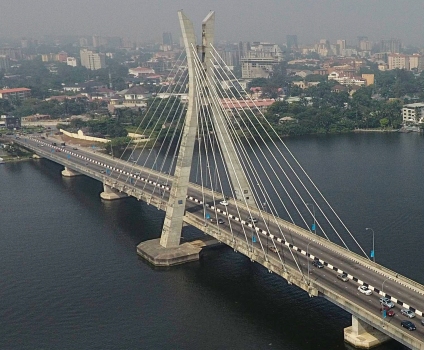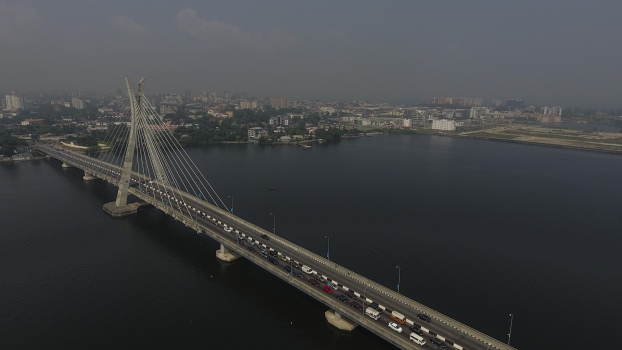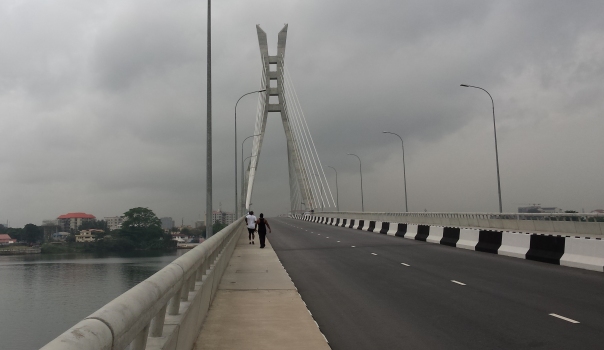General Information
| Completion: | 29 May 2013 |
|---|---|
| Status: | in use |
Project Type
| Function / usage: |
Road bridge |
|---|---|
| Material: |
Prestressed concrete bridge |
| Support conditions: |
for registered users |
| Plan view: |
Structurae Plus/Pro - Subscribe Now! |
| Structure: |
Two-span single-pylon cable-stayed bridge Cable-stayed bridge with semi-fan system |
| Material: |
Structurae Plus/Pro - Subscribe Now! |
| Secondary structure(s): |
Structurae Plus/Pro - Subscribe Now! |
| Structure: |
approach viaduct: Multiple T-section girder bridge |
| Construction method: |
deck of main bridge: Precast segmental construction using launching gantry for registered users deck of approach viaduct: Precast girders with cast-in-situ slab Structurae Plus/Pro - Subscribe Now! |
| Secondary structure(s): |
Structurae Plus/Pro - Subscribe Now! |
Location
Technical Information
Dimensions
| total length | 1 357 m | |
| approach viaducts | ||
|---|---|---|
| total length | 700 m | |
| main bridge | ||
| total length | 635 m | |
| span lengths | 55 m - 2 x 75 m - 2 x 112.5 m - 2 x 75 m - 55 m | |
| number of spans | 8 | |
| bridge surface | 13 500 m² | |
| deck | total width | 21.400 m |
| roadway / carriageway width | 2 x 8.00 m | |
| pylon | height | 91 m |
| number | 1 | |
| stay cables | length | 55 - 119 m |
| number | 4 x 7 = 28 | |
Materials
| pylon |
reinforced concrete
|
|---|---|
| deck |
precast prestressed concrete
|
| piers |
reinforced concrete
|
| stay cables |
steel wire
|
Case Studies and Applied Products

TENSA®FLEX RC – Sliding Finger joints
The Tensa®Flex slip finger can assimilate both horizontal and vertical movements and torsions. Modular structure makes possible the replacement of the system with minimum traffic interferences.
[more]Excerpt from Wikipedia
The Lekki-Ikoyi Link Bridge, is a 1.36 km (0.84 mile) cable-stayed bridge in Lagos State. It links the Phase 1 area of Lekki, with Ikoyi district of Lagos. The bridge was commissioned on 29 May 2013 by the Governor of Lagos State, Babatunde Raji Fashola.
Design and construction
The bridge is the first cable-stayed bridge to be built in Nigeria and was constructed by Julius Berger Nigeria. The bridge has a 9-metre headroom above water level in order to allow for the flow of maritime traffic.
Operation
The bridge is a toll bridge and its use is restricted to private and commercial vehicles with a total seating capacity not exceeding 26. The toll gate is located at the Lekki end of the bridge. Tolling has been controversial with some Lagosians believing that since the bridge was built with public funds, its use should be available at no cost.
The Lagos State government, on the other hand, has argued that the collection of tolls is not only required to maintain the bridge but also to generate funds for building other bridges to link parts of Lagos. The waterway above which the bridge is built is owned and controlled by the Federal Government of Nigeria.
Apart from vehicular traffic, the bridge also serves as a recreational facility. Fitness inclined residents of Lekki phase 1 and Ikoyi use the wide curbs of the bridge for jogging and running, usually in the early mornings and evenings. Tourists and other visitors also find this bridge as one of the places to visit and the bridge is the most photographed place in Lagos.
Text imported from Wikipedia article "Lekki-Ikoyi Link Bridge" and modified on June 12, 2024 according to the CC-BY-SA 4.0 International license.
Participants
Relevant Web Sites
Relevant Publications
- (2013): Planungs- und Ausführungsaspekte der Schrägseilbrücke Lekki-Ikoyi. In: Brückenbau, v. 5 ( 2013), pp. 3-29.
- About this
data sheet - Structure-ID
20059219 - Published on:
10/01/2011 - Last updated on:
18/08/2020









